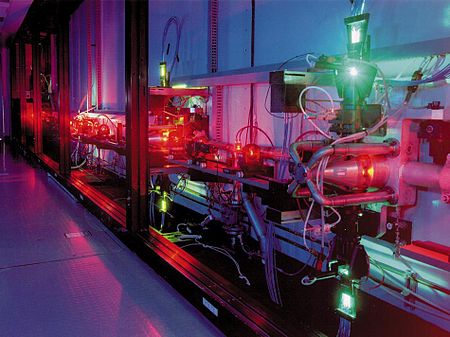Atomic vapor laser isotope separation

Atomic vapor laser isotope separation, or AVLIS, is a method by which specially tuned lasers are used to separate isotopes of uranium using selective ionization of hyperfine transitions.[1][2]
As compared to gas centrifuges the AVLIS process provides high energy efficiency, high separation factors, and a low volume of radioactive waste. The technology could in principle also be used for isotope separation of other elements, which is uneconomic outside specialist applications with current non-laser-based technologies for most elements.
A similar technology, using molecules instead of atoms, is molecular laser isotope separation (MLIS).
Due to the possibility to achieve much higher enrichment with much lower energy needs than conventional uranium hexafluoride based methods of uranium enrichment, it is of concern both for nuclear proliferation and the possibility to produce fuel for light water reactors much more cheaply, using the 235
U contained in reprocessed uranium and depleted uranium as well as natural uranium. At present extracting 235
U from all those sources is only economical up to a certain degree, leaving tons of 235
U still contained in waste products. In the past, advances in uranium enrichment technology have led to stored depleted uranium being processed again to extract more useful 235
U from it.[3]
Principle[]
The absorption lines of 235U and 238U differ slightly due to hyperfine structure; for example, the 238U absorption peak of 502.74 nanometers shifts to 502.73 nm in 235U. AVLIS uses tunable dye lasers, which can be precisely tuned, so that only 235U absorbs the photons and selectively undergoes excitation and then photoionization. The ions are then electrostatically deflected to a collector, while the neutral unwanted uranium-238 passes through.
The AVLIS system consists of a vaporizer and a collector, forming the separation system, and the laser system. The vaporizer produces a stream of pure gaseous uranium.
Laser excitation[]
The laser commonly used is a two-stage tunable pulsed dye laser usually pumped by a copper vapor laser;[4][5] the master oscillator is tunable, narrow-linewidth, low noise, and highly precise.[6] Its power is significantly increased by a dye laser amplifier acting as optical amplifier. Three frequencies ("colors") of lasers are used for full ionization of uranium-235.[7]
For AVLIS in other elements, such as lithium, tunable narrow-linewidth diode lasers are used.[8]
Commercialization and international significance[]
In the largest technology transfer in U.S. government history, in 1994 the AVLIS process was transferred to the United States Enrichment Corporation for commercialization. However, on June 9, 1999, after a $100 million investment, USEC cancelled its AVLIS program.
AVLIS continues to be developed by some countries and it presents some specific challenges to international monitoring.[9] Iran is now known to have had a secret AVLIS program. However, since it was uncovered in 2003, Iran has claimed to have dismantled it.[10][11]
Brief history[]
The history of AVLIS, as recorded in the open refereed literature, began in the early-mid 1970s in the former Soviet Union and the United States.[12] In the US, AVLIS research was mainly carried out at the Lawrence Livermore National Laboratory although some industrial laboratories were early players. Tunable laser development for AVLIS, applicable to uranium, has also been reported from several countries including Pakistan (1974), Australia (1982-1984), France (1984), India (1994), and Japan (1996).[12]
See also[]
- Australian Atomic Energy Commission
- Calutron
- (CRISLA)
- Gaseous diffusion
- List of laser articles
- Separation of isotopes by laser excitation (SILEX)
- Nuclear fuel cycle
- Nuclear power
References[]
- ^ L. J. Radziemski, R. W. Solarz, and J. A. Paisner (Eds.), Laser Spectroscopy and its Applications (Marcel Dekker, New York, 1987) Chapter 3.
- ^ Petr A. Bokhan, Vladimir V. Buchanov, Nikolai V. Fateev, Mikhail M. Kalugin, Mishik A. Kazaryan, Alexander M. Prokhorov, Dmitrij E. Zakrevskii: Laser Isotope Separation in Atomic Vapor. Wiley-VCH, Berlin, August 2006, ISBN 3-527-40621-2
- ^ https://www.wise-uranium.org/edumu.html
- ^ F. J. Duarte and L.W. Hillman (Eds.), Dye Laser Principles (Academic, New York, 1990) Chapter 9.
- ^ C. E. Webb, High-power dye lasers pumped by copper vapor lasers, in High Power Dye Lasers, F. J. Duarte (Ed.) (Springer, Berlin, 1991) Chapter 5.
- ^ F. J. Duarte and J. A. Piper, Narrow linewidth high prf copper laser-pumped dye-laser oscillators, Appl. Opt. 23, 1391-1394 (1984).
- ^ ""Annex 3": List of Items to Be Reported to IAEA". Iraqwatch.org. Archived from the original on 2011-05-14. Retrieved 2010-11-22.
- ^ I. E. Olivares, A. E. Duarte, E. A. Saravia, and F. J. Duarte, Lithium isotope separation with tunable diode lasers, Appl. Opt. 41, 2973-2977 (2002).
- ^ Ferguson, Charles D.; Boureston, Jack (March–April 2005). "Laser Enrichment: Separation Anxiety". Council on Foreign Relations. Retrieved 2010-11-22.
- ^ Ferguson, Charles D.; Boureston, Jack (June 17, 2004). "Focusing on Iran's Laser Enrichment Program" (PDF). FirstWatch International. Retrieved 2010-11-22.
- ^ Paul Rogers (March 2006). "Iran's Nuclear Activities". Oxford Research Group. Archived from the original on 2007-02-06. Retrieved 2010-11-22. Cite journal requires
|journal=(help) - ^ a b F. J. Duarte (2016). "Tunable laser atomic vapor laser isotope separation". In F. J. Duarte (ed.). Tunable Laser Applications (3rd ed.). Boca Raton: CRC Press. pp. 371–384. ISBN 9781482261066.
External links[]
- USEC News Release Cancelling AVLIS
- Report on Iranian AVLIS program
- Oxford Research Group report on Iran's nuclear activities.
- Laser isotope separation uranium enrichment
- Overview of Uranium Atomic Vapor Laser Isotope Separation R.M. Feinburg and R.S. Hargrove. UCRL-ID-114671 August 1993.
- Laser Isotope Separation page at LLNL
- Chemical processes
- Isotope separation
- Uranium
- Laser applications